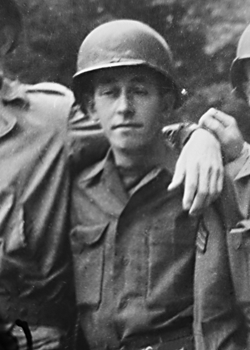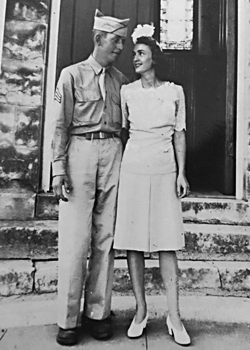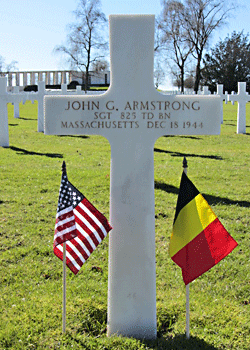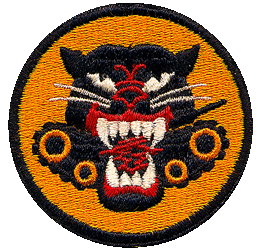 John G. Armstrong
John G. Armstrong
Biography: John G. Armstrong was born in Monkton, Maryland, on September 5, 1921. He was the son of Frederick and Emma Armstrong and attended local schools through the 9th grade. He was living in Groton, Massachusetts, prior to the war and his enlistment records indicates that after leaving school, he worked as a chauffeur or driver of a taxi, truck or tractor.
Service Time: John entered the service on September 15, 1942, at Fort Devens, MA on September 15, 1942. He was assigned to Company A of the 825th Tank Destroyer Battalion, rose to the rank of Sergeant and was put in command of the 1st Squad of Section 1. At some point, while on leave, John married the former Margaret Scott.
The 825th sailed from the New York port on May 30th, 1944, aboard the Queen Elizabeth, arriving in Scotland on June 5th. After an additional 2 months of training, the men and equipment were loaded on LST’s and arrived on Utah Beach in Normandy, France. They were equipped with 3″ towed guns and initially assigned to the Communications Zone and performed 12th Army Group security duties between August and December, 1944.
 The battalion entered combat near Malmedy, Belgium, on December, 17th. The next morning, two 3” anti tanks guns of A Company’s Lieutenant Jack Doherty’s 1st and 2nd Squad, 1st Platoon were knocked out by Kampfgruppe Peiper (formation led by Waffen SS Officer Joachin Peiper) after crossing the Amblève River bridge at Stavelot. They made contact with the enemy and First and Second Squad were unable to reach the positions designated, due to enemy fire. When they attempted to withdraw and take up positions to return enemy fire, they were hit by direct fire from the Germans. The M3 vehicle of the First Squad was hit by a German mortar shell. The German SS troops used a burp gun (a lightweight submachine gun) to kill Sgt. John G. Armstrong and part of his crew, who were trying to get out of the burning vehicle. Tony Calvanese and Léo Brunette were the only men that managed to get out of the halftrack and escape capture. Second Squad’s gun and half-track were also knocked out but the men were able to escape and seek refuge in nearby houses. In addition to Sgt. Armstrong, Pvt. Conley Leach, Pvt. Frank Richesin, Pvt Bernard Gallagher, Pvt. Douglas Newman and Pvt Fowler Williams were killed.
The battalion entered combat near Malmedy, Belgium, on December, 17th. The next morning, two 3” anti tanks guns of A Company’s Lieutenant Jack Doherty’s 1st and 2nd Squad, 1st Platoon were knocked out by Kampfgruppe Peiper (formation led by Waffen SS Officer Joachin Peiper) after crossing the Amblève River bridge at Stavelot. They made contact with the enemy and First and Second Squad were unable to reach the positions designated, due to enemy fire. When they attempted to withdraw and take up positions to return enemy fire, they were hit by direct fire from the Germans. The M3 vehicle of the First Squad was hit by a German mortar shell. The German SS troops used a burp gun (a lightweight submachine gun) to kill Sgt. John G. Armstrong and part of his crew, who were trying to get out of the burning vehicle. Tony Calvanese and Léo Brunette were the only men that managed to get out of the halftrack and escape capture. Second Squad’s gun and half-track were also knocked out but the men were able to escape and seek refuge in nearby houses. In addition to Sgt. Armstrong, Pvt. Conley Leach, Pvt. Frank Richesin, Pvt Bernard Gallagher, Pvt. Douglas Newman and Pvt Fowler Williams were killed.
 John was awarded the Silver Star and the Purple Heart. He was buried in the American War Cemetery at Henri-Chapelle in Hombourg, Belgium, Plot G Row 6 Grave 46. I want to thank Serge Lemaire for providing the photo of John and the information for this tribute. I also want to thank the personnel at Henri-Chapelle for providing the photo of his grave marker.
John was awarded the Silver Star and the Purple Heart. He was buried in the American War Cemetery at Henri-Chapelle in Hombourg, Belgium, Plot G Row 6 Grave 46. I want to thank Serge Lemaire for providing the photo of John and the information for this tribute. I also want to thank the personnel at Henri-Chapelle for providing the photo of his grave marker.
